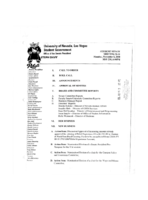Search the Special Collections and Archives Portal
Search Results

Transcript of interview with Susan Jones Watson by Claytee White, February 20, 2013
Date
Archival Collection
Description
A resident of Southern Nevada from the age of three, Susan Watson shares her memories of growing up and living in Las Vegas. After a year in Boulder City, Susan's father bought an old army barrack and converted it to a home in North Las Vegas; Susan remembers playing in the desert with her siblings and attending elementary and middle school before starting at Rancho High. Watching her mother design costumes for Strip performers and beautiful dresses for her own high school dances no doubt helped Susan develop her own sense of taste and style - something that she would put to good use over many years as an interior designer. Before that though, Susan shares her memories of what life was like in the Las Vegas of the 1950s and 1960s: cruising Fremont Street; movie nights; after-school work; favorite teachers; lunches on the lawn; and dance club. All combine to paint a vivid picture of a smaller town and a simpler time in the Las Vegas valley.
Text

Transcript of interview with Harriett Thornton Hicks by Claytee D. White, October 28, 2009
Date
Archival Collection
Description
Harriett Thornton Hicks was born June 8, 1913,in Parowan, Utah; the thirteenth child of 14. She tells of her pioneer family who dwelled in two log cabins—one for cooking and one for sleeping. In 1931, she moved to Las Vegas to join two older sisters who had relocated here. She was picked up at the train by young Charles Hicks, who was a friend of her sisters. Charles had a car and offered to provide transportation. Within three years, the two were married. She quit her drug store job to raise a family and he worked for the railroad, the only business at the time in Las Vegas. At the age of 96, Harriett recalls a range of community milestones, such as the Boulder Dam, the news of Pearl Harbor bombing, Fremont Street, the Biltmore Hotel, and how to live in a city with mob influences.
Text
Charles Brinker oral history interview
Identifier
Abstract
Oral history interview with Charles Brinker conducted by Doug Coombs on March 19, 1978 for the Ralph Roske Oral History Project on Early Las Vegas. Brinker discusses his experiences living in Southern Nevada and his career in carpentry. Brinker also discusses his background in watch repair, his move to Las Vegas, Nevada from West Virginia, his experiences in homesteading, grocery shopping in early Las Vegas, the building of his house for his family, and his various jobs and projects as a carpenter.
Archival Collection
Sidney R. Whitmore Collection
Identifier
Abstract
The Sidney R. Whitmore Collection (approximately 1885-1970) contains land deeds and other documents about Mount Diablo, Nevada; documents detailing parts of his family history; and eight framed paintings of landscapes and portraits.
Archival Collection
Michael Howe oral history interview
Identifier
Abstract
Oral history interview with Michael Howe conducted by Claytee D. White and Stefani Evans on July 05, 2017 for the Building Las Vegas Oral History Project. In this interview, Howe discusses his upbringing in Las Vegas, Nevada and growing up in the Huntridge neighborhood. He talks about joining the Las Vegas Department of Planning in 2007, projects he has been a part of, and involving the community when development planning. Howe describes the master planning for Downtown area of Las Vegas, public-private partnerships, and the idea of sustainability in public spaces. Lastly, Howe discusses the importance of developing transportation accommodations in the city.
Archival Collection

Ruby C. Leavitt interview, November 30, 1986: transcript
Date
Archival Collection
Description
On November 30, 1986, collector Patton Alberti interviewed Ruby Canonic Leavitt (born 1907 in Genoa, Nevada) at her home in Reno, Nevada. Mrs. Leavitt discusses her time as a teacher in Verdi, Nevada, as well as other places in Northern Nevada. She also discusses the changes she has seen in teaching and in the towns she has lived in over time.
Text
Max Velasquez oral history interview
Identifier
Abstract
Oral history interview with Max Velasquez conducted by Janice F. Hurtubise on March 08, 1981 for the Ralph Roske Oral History Project on Early Las Vegas. In this interview, Velasquez discusses his personal history as a construction worker in Las Vegas, Nevada. He describes the construction projects he worked on and the differences between 1950s construction and construction at the current time. Velasquez goes on to discuss the government regulations workers had to follow, how water pipelines were laid, and the types of equipment used in construction. Lastly, Velasquez talks about the bidding process for contractors and environmental changes in Las Vegas.
Archival Collection

Aerial photograph of Las Vegas Wash looking northwest, June 5, 1973
Date
Archival Collection
Description
Aerial view of Las Vegas Wash at Lake Mead Blvd. and Pecos Street in North Las Vegas.
Transcribed Notes: Stamped & written on back: CNLV Engineering Dept. - Date Jun 5 1973; Project - Land use Vegas Wash - SE; Lake Mead & Pecos Flood Control in county
Image

Transcript of interview with Della Mae Rostine by Irene Rostine, October 31, 1991
Date
Archival Collection
Description
Della Mae Rostine left Missouri with her husband, Rocco, in 1942, and headed to Las Vegas. Happy to leave behind the hard life and instability the mining industry had to offer, after living in Las Vegas for the first year the couple settled in Henderson, Nevada, known as the townsite at that time. Della Mae’s oral history provides readers with a glimpse of what life was like for the 14,000-plus individuals and families who also moved to southern Nevada during the same period in order to make a living in the growing “war work” industry the area had to offer. Della Mae shares the hardships faced in finding housing, especially for families with children. She discusses challenges ranging from securing home furnishings to purchasing groceries, including the rations on gasoline and butter at that time. Della Mae also discusses her experiences with the Basic Magnesium plant where her husband was hired as a construction worker in the early days of the plant and where she would work briefly as a machinist making shell casings and monitoring the down time on the production line. She also touches briefly on the social opportunities the BMI plant, and later Rheem Manufacturing, offered to the workers and their families. When World War II ended, more than half of residents of the townsite left, leaving fewer than 7,000 people to form what would later become the city of Henderson, Nevada. Della Mae’s oral history is a brief overview of a family life which began when BMI was just getting off the ground and continued through the many changes that took place in the BMI complex and the town site over several decades. The timing of the Rostine family’s arrival and the fact that they stayed and made a permanent home in Henderson led to their designation as one of Henderson’s “founding families.”
Text

Meeting minutes for Consolidated Student Senate, University of Nevada, Las Vegas, November 06, 2000
Date
Archival Collection
Description
Text
